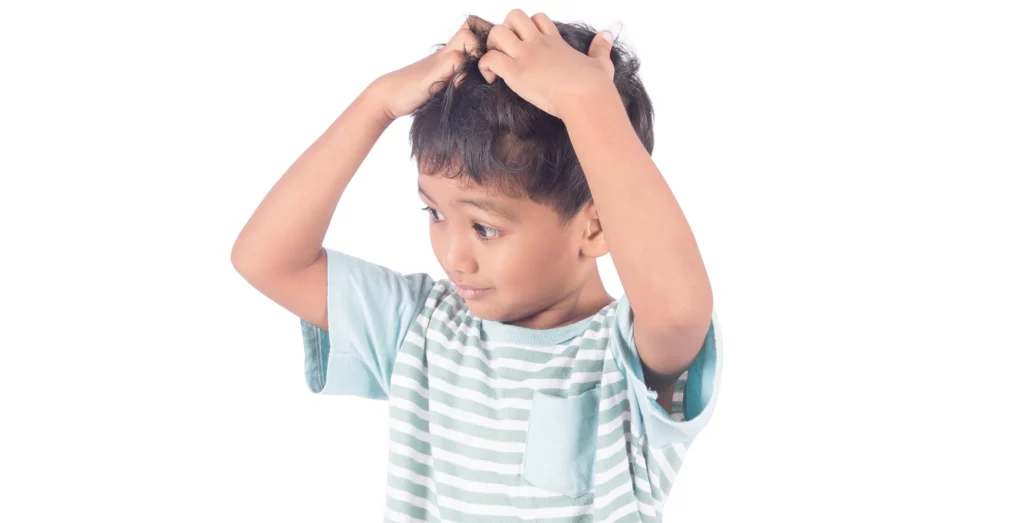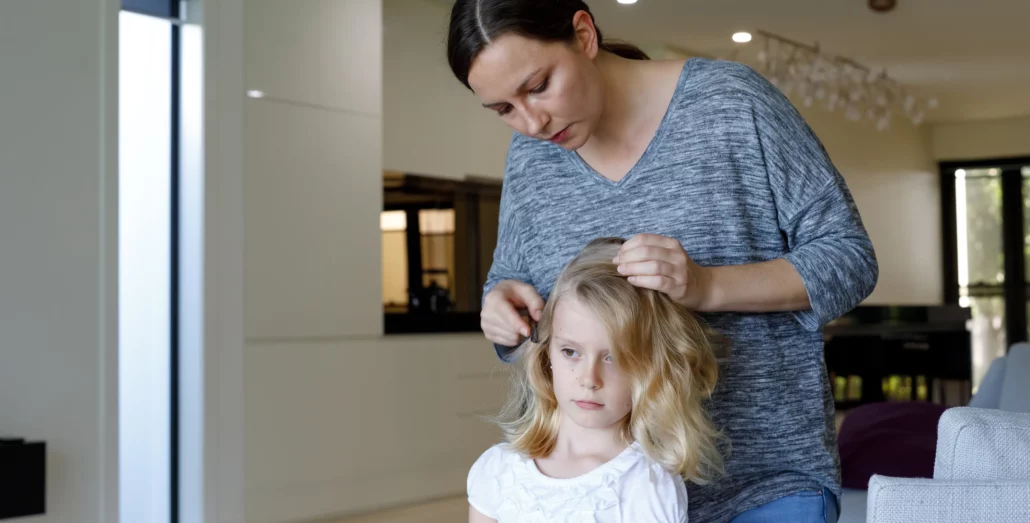Dealing with an itchy scalp can be a frustrating experience, and it can be challenging to determine whether it is caused by lice or dandruff. While both conditions may appear similar, they are fundamentally different, and it is essential to distinguish between them to determine the right treatment approach.
Lice are tiny, wingless insects that live on the scalp and feed on human blood. They are highly contagious and can spread rapidly through direct head-to-head contact. Lice lay eggs, also known as nits, on the hair shafts close to the scalp. These lice eggs are typically what is confused with dandruff.
What are the Main Differences Between Lice Eggs vs. Dandruff?
Lice are living insects that can move around, while lice eggs are the small, oval-shaped objects that the lice lay on the hair shafts. Lice eggs are usually about the size of a pinhead and are white or yellow in color, and are attached to the hair shafts with a glue-like substance that can be difficult to remove. Dandruff, on the other hand, is a scalp condition caused by excessive flaking of dead skin cells.
Here’s how to spot the difference between lice and dandruff:
1) Appearance
One of the most apparent differences between lice and dandruff is their appearance. Liceare visible to the naked eye and are about the size of a sesame seed. They are usually found close to the scalp and their eggs, also known as nits, can be seen attached to individual hair shafts. Dandruff, on the other hand, appears as white or yellowish flakes that fall off the scalp and onto the shoulders.
2) Itching Both lice eggs and dandruff can cause itching, but lice infestations tend to be much more severe.
- Lice bites can cause an intense itching sensation, which may lead to scratching and skin irritation.
- Dandruff, on the other hand, typically causes mild itching, and the flakes may not be accompanied by any discomfort.
3) Location
Lice infestations are typically localized to the scalp and hairline, while dandruff can occur on any part of the scalp. It’s also important to note that dandruff will move farther along the hair shaft as you brush the hair, while lice and eggs typically stay close to the scalp – meaning dandruff will usually be much more visible during everyday activities.
Symptoms of Lice Eggs vs. Dandruff

The symptoms of lice vs. dandruff can be quite different, and understanding these differences is crucial for proper diagnosis and treatment. Here are some key symptoms of lice and lice eggs vs dandruff:
Symptoms of lice and lice eggs:
- Intense itching on the scalp, neck, and ears
- The presence of eggs on hair shafts close to the scalp
- Crawling sensation on the scalp
Symptoms of dandruff:
- White or yellowish flakes on the scalp and hair, which can be seen on clothing
- Itchy or dry scalp, which can be worse in certain weather conditions or after using certain hair products
- Scalp irritation or redness, which can be caused by scratching.
Lice Treatment Options
The treatment for lice and dandruff is entirely different, and it is crucial to use the appropriate approach for each condition. Lice infestations require the use of specialized lice shampoos, combs, and/or treatments to eliminate both the adult lice and their eggs.
Dandruff, on the other hand, can be treated with over-the-counter shampoos and topical treatments that contain antifungal or anti-inflammatory ingredients.
Lice Clinics of America has three revolutionary lice treatments. The FDA-cleared AirAllé is a medical device that kills live lice bugs and their eggs (nits) through dehydration and desiccation. This revolutionary alternative treats head lice through a specific combination of temperature, airflow, time, and technique. Because the AirAllé device is so effective at killing lice eggs (which are the hardest for traditional lice products to kill), the chances of needing a follow-up treatment are less than 1%.
The OneCure™ Home Treatment Kit is the first and only at-home, heated-air solution clinically proven to kill lice, super lice, and 99.2% of eggs, all in a single treatment. OneCure uses the same non-toxic, pesticide-free technology proven in our clinics, but can be administered at home. The CURE! Lice Remover Kit is a home treatment kit that allows you to treat head lice with a safe, non-toxic, and pesticide-free gel that kills lice and super lice.
How to Prevent Lice Infestations & Dandruff

Fortunately, both dandruff and lice are preventable if the right steps are taken. To help prevent a lice infestation, it’s important to:
- Avoid head-to-head contact: Lice are most commonly spread through head-to-head contact, so try to avoid activities that involve close contact with others, such as hugging or leaning heads together.
- Avoid sharing personal items: Lice can occasionally spread through sharing personal items such as combs, brushes, hats, scarves, and clothing. Avoid sharing these items with others to reduce the risk of lice infestation.
- Regularly inspect hair and scalp: Regularly inspecting hair and scalp for lice or nits (lice eggs) can help identify infestations early and prevent them from spreading.
- Use preventative products, such as essential oils, which can deter lice. Peppermint, rosemary and tea tree oils can all help in preventing lice.
To help prevent dandruff, particularly if you are prone to a dry scalp, remember to maintain good scalp hygiene by regularly shampooing your hair and scalp (which can help remove excess oil and dead skin cells that contribute to dandruff).
Lice and Dandruff FAQs
Can lice be mistaken for dandruff?
Lice can be mistaken for dandruff because both can cause itching and white flakes to appear in the hair. However, there are some key differences between lice and dandruff– especially when it comes to overall appearance, location, and the symptoms that each causes.
In general, dandruff flakes are usually larger and more visible than lice eggs, and they tend to be scattered throughout the hair rather than being located close to the scalp.
How do I know if I have dry scalp or lice?
Dry scalp and lice infestation can have similar symptoms, such as itching and flaking, which can make it difficult to tell them apart. To differentiate between dry scalp and lice, you can examine your scalp and hair for the presence of live lice or nits.
Dry scalp is a common condition that occurs when the scalp is too dry and lacks sufficient moisture. Symptoms of dry scalp include itching, flaking, and sometimes mild redness. The flakes produced by dry scalp are usually smaller and less oily than those produced by dandruff, and they tend to be scattered throughout the hair. Lice can be difficult to see, but you may be able to spot them moving on the scalp or hair; nits are usually easier to see and are often found close to the scalp.
Why do I keep finding nits but no lice?
If you keep finding nits but no lice, it could mean that you have successfully eliminated the live lice from your hair, but the nits are still attached to the hair shafts. Nits are firmly attached to the hair shafts near the scalp with a glue-like substance, so they can be difficult to remove and usually stay on the head longer than lice.
It’s also possible that you are mistaking other particles, such as dandruff or hair product buildup, for nits. To differentiate between nits and other debris, nits are usually oval-shaped and about the size of a pinhead, while dandruff flakes are usually larger and scattered throughout the hair.
Why is my scalp itchy but no dandruff or nits?
There can be several reasons why your scalp is itchy but there is no dandruff or nits:
- Allergies: Your scalp may be itchy due to an allergic reaction to certain hair care products such as shampoos, conditioners, or styling products. Some people may also be allergic to certain fabrics or metals that come into contact with their scalp, such as wool or nickel.
- Dry scalp: A dry scalp can cause itching, even if there is no dandruff present. This can occur due to harsh shampoos, cold weather, and low humidity, among other factors
- Scalp psoriasis: Psoriasis is a chronic autoimmune condition that causes red, scaly patches to appear on the skin. When it affects the scalp, it can cause itching and flaking.
To learn more about lice prevention and tips for treatment, visit our blog or find a lice clinic near you.

